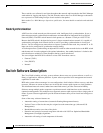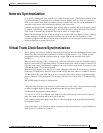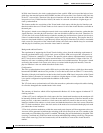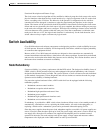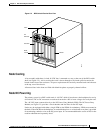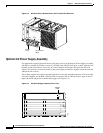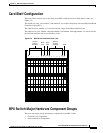
1-42
Cisco BPX 8600 Series Installation and Configuration
Release 9.3.10, Part Number 78-11603-01 Rev. D0, July 2001
Chapter 1 The BPX Switch: Functional Overview
Virtual Trunk Clock Source Synchronization
only if it is not a clock routing trunk (pass sync = no) and therefore the VT ports that are configured for
clock sources cannot route the clock through. Also, the configuration of a virtual trunk, as clock routing
as yes or no (pass sync) will affect all the VI’s on the trunk port, since the clock routing attribute is a
characteristic of the physical interface.
For the software implementation, the default association of clock source internally to the first VI on the
trunk port, when the clock source is configured on the port will continue in the same way as now.
Therefore if we first configure a VT port, for clock, the first virtual trunk will be selected for our
internal reference, which helps us in implementing the local clock switching, transparently to the user.
The logical trunk association is for the implementation reference, since a logical trunk is the way of
connecting the trunk port interface in switch software.
The use of the trunk port as clock source with all of the VTs in failed state, may not be a real customer
scenario and therefore such a configuration is not supported. Also the current switch software
implementation of virtual trunks does not provide an accurate status for the detection of the physical
interface failures, when all the virtual interfaces are failed.The failure of a clock source can be due to
some of the alarm conditions and is determined by the clock diagnostics.
Features:
The VT clocking feature allows the mapping of clock source to one of the suitable logical trunk out of
all of the active VIs of a VT port. The following additional features will be provided, if a VT port is
configured for clock source:
The event log will indicate the clock switch to the physical interface (slot.port)as in the case of a regular
trunk.
If all the VIs fail on physical trunk port, even though this would be configurable as a clock source, the
interface will be taken out of service and removed from the list of selectable sources.
The VI failure and clock switching within the same interface port will be transparent to the other nodes
in the network.
All of the VIs in a trunk port can trigger the nw clock selection depending on the topology
A debug flag can turn on the event logging, whenever a clock switch occurs between the VIs of a trunk
port. The default value for this flag is ‘Disabled’
The normal trunk failures continue to cause clock source switches as they do currently and there is no
effect on regular trunks (non-virtual trunks) with the introduction of this feature.
If the first virtual interface is failed, at a time when the clock source is configured at a node, the node
will behave in the same as currently, and the clock source will be marked for the first interface. Because
of the failure the clock source will not be switched to the new configured interface, but when the clock
diagnostics reports the failure, the VT search will look for the next interface on the port and attach the
source.
When the first interface comes back up, the interface will not be switched back, unless there is a failure
and no alternate VI is available.
The VT search occurs in the cyclic order starting at the current interface and runs through max VI’s. In
IGX the maximum number of Virtual Interfaces is 15 and in BPX the maximum number of VIs is 31 on
a trunk port.
No impact on the Release 9.3 Virtual Ports feature, with the introduction of this feature
Limitations:
The following is a known limitation of the VT clock sources:
Even though the VTs can be configured to pass the clock sync (pass sync = yes), and therefore route the
clock through Virtual Trunks (through the cloud), the stability of the clock is determined by the entry
and exit points in the cloud. This is a current system limitation.



